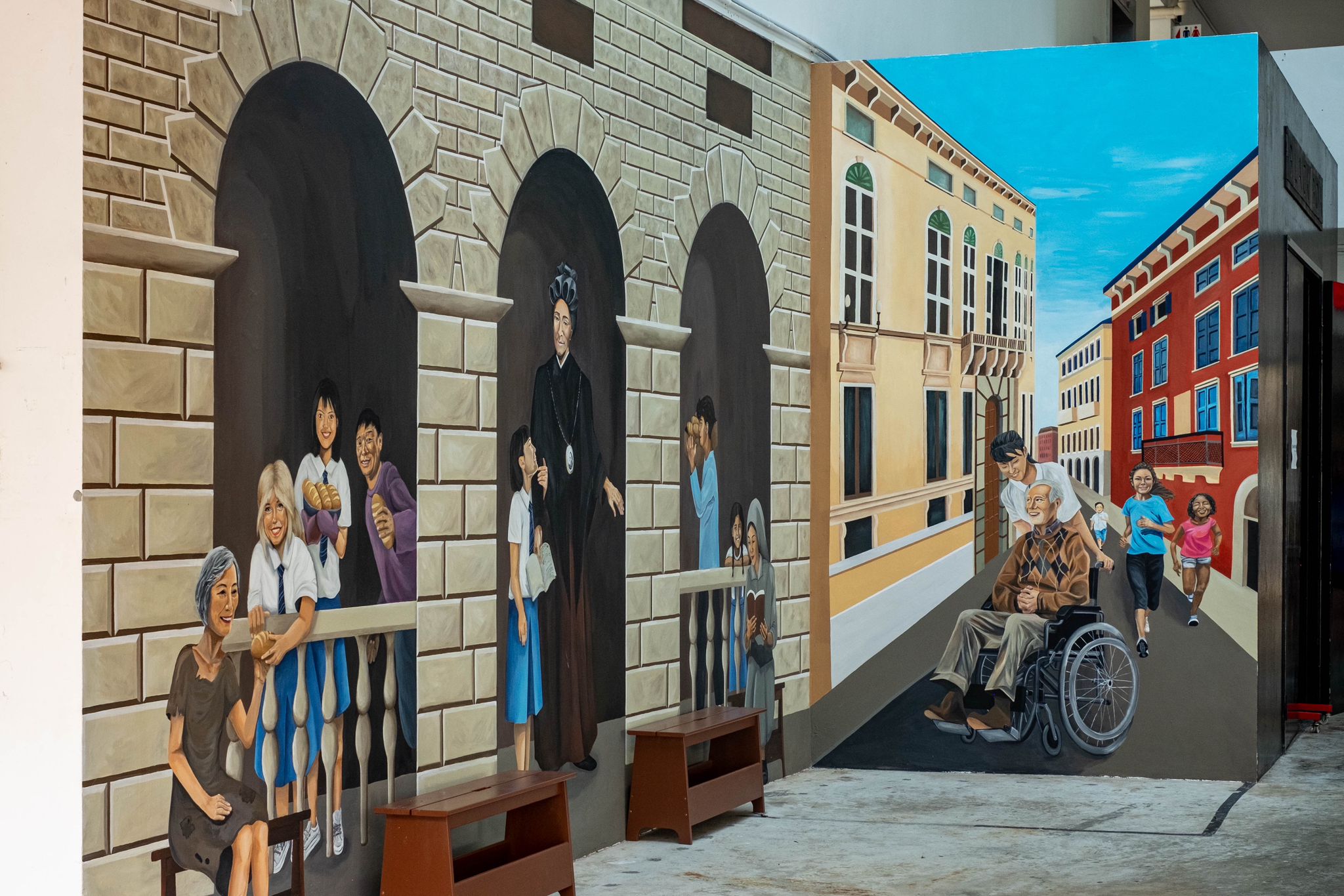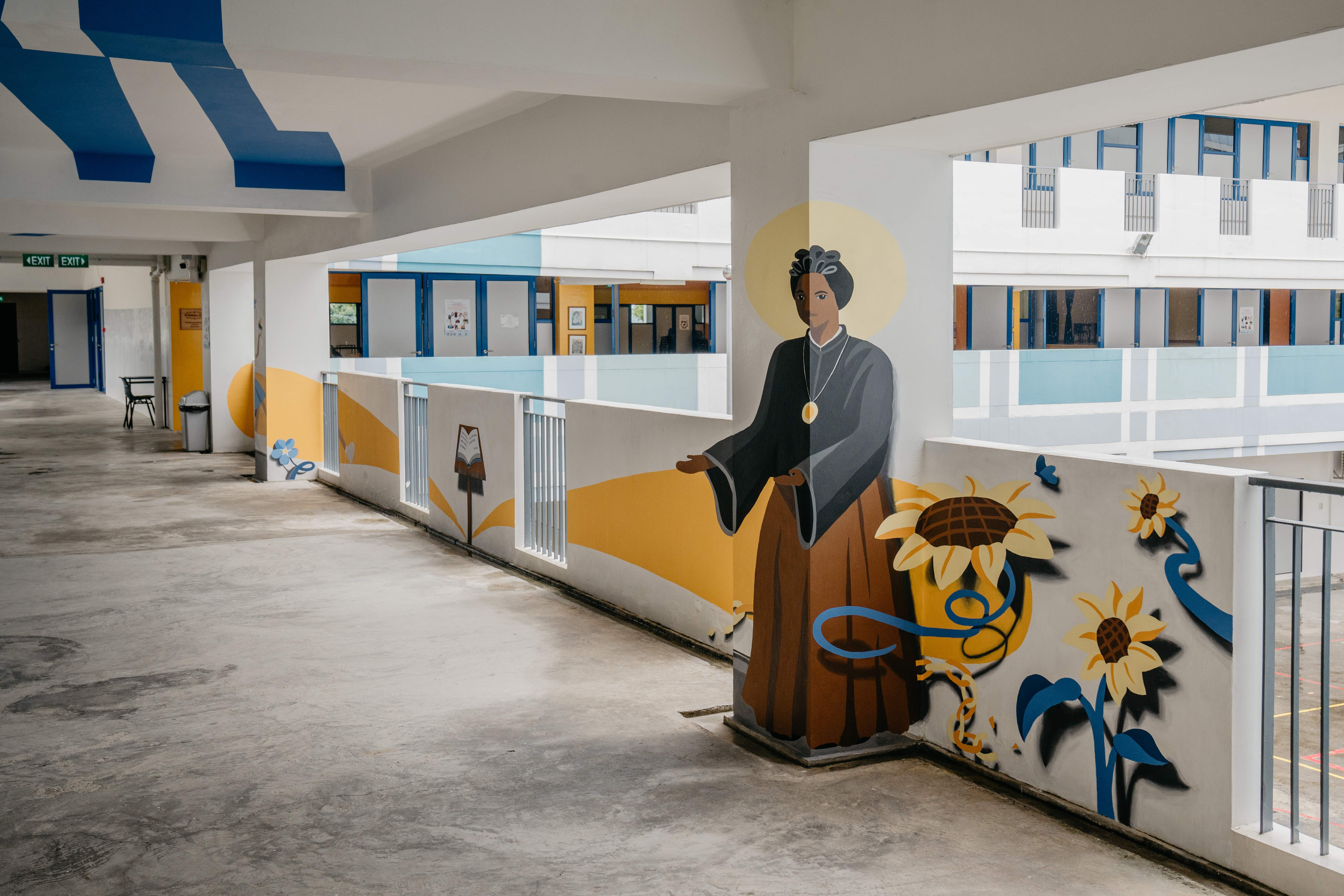Canossian Saints
St. Magdalene of Canossa

This wall mural was painted in 2024 to celebrate the 250th Anniversary of the birth of Our Foundress. Replicating the façade of the Canossa Palace, home to our Foundress, St. Magdalene of Canossa in Verona, the colourful mural that stands at the entrance of the school illuminates our Canossian charism. The scene depicts the charitable spirit of St. Magdalene as exemplified in the interaction between the young and old, and people of different races at the “bread door” to symbolize the global outreach of the Canossian missions. The “bread door” as it is affectionately known was where Our Foundress distributed bread to the poor and hungry. The Sisters continued this tradition at 111 Middle Road, distributing daily necessities to the needy. As illustrated in the mural, we, like the children, are called to be a “bread door” to those around us, feeding those who hunger and thirst with God’s healing love. The benches reflect the interactive nature of the mural, welcoming us to sit with the characters. As we sit next to them, we are invited to contemplate on our humanity. In doing so, we radiate our humility by embracing the young and old around us, lifting them up by our charitable words and deeds, and empowering them to recognise their dignity as children of God. The symbolism of the wall mural echoes the words of St Pope John Paul II when he canonised Magdalene of Canossa on 2 October 1988, as a one who embodies “Charity in Humility; Humility in Charity”.
Saint Magdalene of Canossa's life story is a testament to her unwavering faith and profound compassion for the marginalized and impoverished. Born into privilege in Verona, Italy, she experienced profound loss of her parents and abandonment at a young age, finding solace in her deep devotion to Jesus and Mother Mary. Despite the societal contrasts and upheavals of her time, Magdalene dedicated her life to serving those in need, particularly children, youth, and women affected by poverty and war. Leaving behind her family's wealth, she founded the Daughters of Charity and established herself in the poverty-stricken district of San Zeno, embodying a radical commitment to love and service. Today, her legacy lives on through the global presence of the Daughters of Charity and the Canossian family, continuing her mission of revealing God's love to humanity. Canonized by Pope John Paul II in 1988, Saint Magdalene of Canossa remains a beacon of charity and hope, inspiring countless souls to follow in her footsteps of love and service in a broken world.
St. Josephine Margaret Bakhita

“If I were to meet those slave raiders that abducted me and those who tortured me, I'd kneel down to them to kiss their hands, because, if it had not have been for them, I would not have become a Christian and a religious."
This wall mural was painted in 2023 in preparation for the school’s 145th anniversary celebration in 2024. Greeted by the image of St. Josephine Margaret Bakhita as one walks towards the Hall, the word “Forgive” radiates in all directions. Like St. Bakhita, we are called to forgive. Forgiveness is a profound expression of love, compassion, and humanity. It enables us to move forward with grace, empathy, and a renewed sense of hope, enriching both our lives and the lives of those around us. When we walk out of the Hall, “Faith” is projected in all angles. We are called to walk in faith, and not merely by sight. St. Bakhita reminds us that with faith, we can be freed from our modern enslavement, and grow into the person we are called to become. Faith provides a foundation for living a meaningful, purposeful, and fulfilling life. It enriches our experiences, strengthens our relationships, and sustains us through life's joys and challenges. The anamorphic art symbolises the importance of being centred. When we forgive and walk in faith, we experience peace and grow in hope and optimism to become Canossians of Influence.
Saint Josephine Margaret Bakhita's life journey epitomizes the triumph of the human spirit over adversity. Kidnapped as a child by Arab slave traders, she endured unimaginable hardships, being bought and sold numerous times and subjected to brutal treatment. Despite enduring 12 years of captivity and experiencing deep physical and emotional scars, she found solace and hope through her encounter with the Canossian Sisters in Venice, where she discovered God's love and her own innate dignity. Refusing to return to slavery, she successfully fought for her freedom in court, embracing a new life of faith and service. Baptized and named Josephine Margaret and Fortunata, she dedicated herself to the service of God as a Canossian Sister, embodying forgiveness, love, and perseverance. Her remarkable journey from slavery to sanctity continues to inspire countless souls, reminding us of the transformative power of faith and the resilience of the human spirit in the face of adversity.

